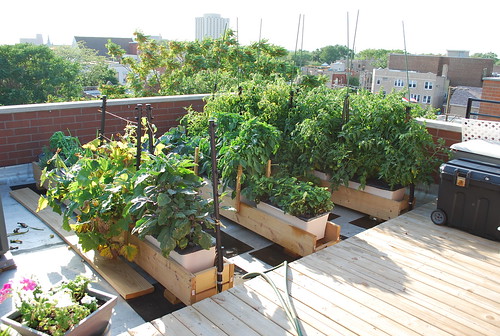

2008 was my first year to seriously try to grow something out of a garden. I used a SIP (sub irrigated planter) because it seemed to be the best for my needs. I grew on my roof because that was the only available space. It is a learning year for me but I’d like to share with you my thoughts and some lessons learned at the half-way point.
1. Watch for pests and disease and take preventative measures. - I have the dates that my plants were affected on a calendar; you won't catch me napping again. This year, it included white flies on my tomatoes, powdery mildew on my zucchini and cucumbers, and mosquitoes. All are easily treated, especially if caught early enough.
2. Build a reliable staking / trellis system that can support the plants, act as a wind barrier for our Chicago windy springs, and give the plants something to climb on. This year I tried plastic stakes and twine for the tomatoes and it just wasn’t strong enough. The plastic bends and the twine will cut into the plants. I’ll need a sturdy material (metal or wood) in a cage-like set-up so I can shrink wrap the cages for damaging winds and have them strong enough to hold the plants as they grow.
3. Look at an automatic watering system (aws). I’ve watered every day, mostly twice a day. Although it takes five minutes, it would be difficult if I missed a day or two. Bruce has developed a very easy aws using a Hudson valve to regulate the water levels. He's had success so far and I think that I'll be looking in to it next year. More details can be found here.
4. Be diligent on timing of crops and rotating out for the next micro season. My lettuce was great in the spring, as was the broccoli but then it bolted and I was left figuring out what to do. I’ve since added a few more tomatoes and some bush beans and will try to swap out strawberries and zucchini for another round of broccoli and lettuce or spinach. I’ll know more next year about what to look for, timing and crop options.
5. Buy all of my supplies in the fall for the spring. Chicago does not have a good all-in-one center for urban gardening. I have to run to four different places for four different things and then have to drive to the suburbs for some others. Hydrated lime was a tough find this year as was mosquito pellets. I can order online but this city is big enough, there should be better options.
6. Start plants from seed. This year, due to ease of use and the fact that it was my first year, I bought starters from garden centers. It was okay but you can get better varieties from seed as well as varieties that are disease resistant and weather resistant.
7. Plant vegetables that will give you a high yield for the space. Onions and strawberries are really good but they haven’t yielded much. Tomatoes, peppers, lettuce, broccoli, zucchini, eggplant were really good. I’m hoping beans will be too.
8. Share the knowledge. When I started in the spring, I found very little about how to do any of this. There were lots of pictures and forums but conflicting advice and a general superiority complex from the traditional agriculture community. This blog will change that. We’re hoping that it will be not only informative but entertaining and timely.
We’re open to comments and ideas. Keep them coming. Thanks much.
2 comments:
Hi Russ,
Nice summary of your experiences to date.
I think you've done a tremendous job of educating yourself, and as you've mentioned to me offline, friends of yours who come over and look at your garden.
As you said, there's not a whole lot of good information out there, so I'm glad you're willing to share what you've learned.
I think you should post your bowl of tomatoes...
Post a Comment